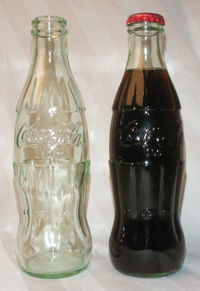Less is More
 According to a recent study by DoubleClick Performics, "Sixty percent of online consumers consider environmental consciousness an important company trait." Stuart Larkins, senior vice president of search at DoubleClick Performics, adds, "With so many consumers online researching and purchasing products, retailers should include relevant environmentally-conscious information throughout their paid and natural search campaigns, affiliate promotions, display ads and e-mail."
According to a recent study by DoubleClick Performics, "Sixty percent of online consumers consider environmental consciousness an important company trait." Stuart Larkins, senior vice president of search at DoubleClick Performics, adds, "With so many consumers online researching and purchasing products, retailers should include relevant environmentally-conscious information throughout their paid and natural search campaigns, affiliate promotions, display ads and e-mail." BuzzBack Market Research surveyed U.S. and UK consumers and found that 57 percent of U.S. consumers recycle glass, 57 percent purchase recycled products and another 55 percent purchase recycled paper. With all of this environmental buzz in the media, how can consumer goods companies take advantage of this trend? Packaging is the answer.
Use Less, Re-Use More
Companies such as PepsiCo, Hewlett-Packard (HP), Coca-Cola, Nestle Waters North America and Kraft Foods are lessening their impact on the Earth without altering their brand image.
For example, Nestlé Waters North America gave Poland Spring's half-liter bottle a new look, with 30 percent less plastic than the average half-liter plastic beverage container. Weighing 12.5 grams on average, the new Eco-Shape bottle is the lightest half-liter plastic beverage container on store shelves (as of 2007).
Recently, PepsiCo introduced its lightest 500mL flavored non-carbonated beverage bottle yet. The company reduced the plastic in this bottle by 20 percent, which will eliminate approximately 20 million pounds of waste from the environment.
Robert Lewis, vice president of worldwide beverage packaging and equipment development, PepsiCo, says, "After a full year of hard work from multiple corners of the company, we hit the trifecta -- a bottle that satisfied the needs of our system, our consumers and the environment."
The new bottle will be launched through established trademarks of Lipton Iced Tea, Tropicana juice drinks, Aquafina FlavorSplash and Aquafina Alive, in 12-packs and 24-packs. In addition to a 20 percent reduction in the plastic resin, there will be a 10 percent reduction in the label size and a 5 percent reduction in the shrink wrap film used to wrap the multi-packs.
In 2006, The Coca-Cola Company advanced in its sustainable efforts (known as e3) with a focus on improving efficiency, lifecycle effectiveness and eco-innovation. The initiative is said to have saved 89,000 metric tons of glass last year alone, and reduced the carbon dioxide equivalent to planting 13,000 acres of trees.
The most recent fruition of this initiative is a newly designed 600mL PET bottle. The Ultralight Bottle weighs 18 percent less than the previous one, and there are plans to expand the technology to other brands and packaging options. In 2007, the company invested in a closed loop recycling plant to provide 6,000 tons of recycled PET plastic material for use in new bottles.
Just the Beginning
Kraft Foods reveals its sustainability efforts through the changing of all varieties of its Milka 100 g chocolate tablets. By switching from aluminum foil wraps in a paper sleeve, to a single layer of packaging, not only is it easier for consumers to open and reseal the packages, but it created a 58 percent reduction in primary packaging.
Roger Zellner, director global technology and quality sustainability for Kraft Foods, reinforces, "In projects such as these, optimizing our packaging design and materials has a positive effect on the environment for the entire life of the product -- it means less energy and materials are used in production, shipping and distribution to the end consumer, while protecting the product and providing consumer preferred convenience."
The food and beverage categories are not alone in this push. HP shows that technology companies are on the same route. In 2007, HP revealed results of its packaging improvements in North America. The company completely removed PVC from its packaging, making it more easily disposable and reducing its weight, saving energy and transportation costs. Other highlights include the use of PET materials from 100 percent recycled content and the use of biopolymers, which are biodegradable materials made from crops such as sugar beet and corn.
Since 2003, the company has reduced overall package weight for inkjet cartridge multi-packs by 80 percent, quadrupling the number of packages that can be carried in a single truckload. HP estimates that the redesigned packaging eliminated the use of about 6,800 tons of materials in 2007, more than 1,300 tons of corrugated cardboard and more than 3,000 tons of PVC. This reduced greenhouse gas emissions by an estimated 16,800 tons CO2e -- the equivalent of taking more than 3,000 cars off the road for one year.
A Lighter Future
These are just some of the many efforts companies are implementing in their packaging processes. With a reduction in the use of materials, there are fewer costs for these companies and more environmental impact for the consumers. This trend is on a fast track, and one can predict that it will stay on this course because it proves, so far, a "win-win" for everyone.
